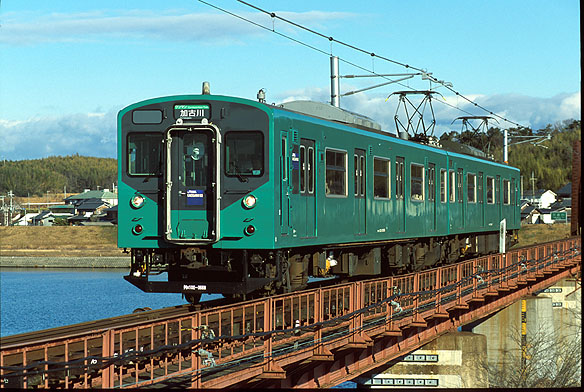Background and overview
To support the reconfiguration of 2-car trainsets, JR West modified selected powered married pairs by incorporating newly built cab-equipped versions of the intermediate cars Moha103 and Moha102. These modified units were reclassified as the 103-3550 series.
A total of eight 2-car sets of the 103-3550 series were introduced in 2004, coinciding with the electrification of the Kakogawa Line. The conversion utilized refurbished components from existing 103 series stock and was intended to provide appropriate rolling stock for local services on the newly electrified section.
Car body
The 103-3550 series features narrow-profile steel carbodies measuring 19,500 mm in length and 2,800 mm in width. To reduce overall weight, the structure incorporates lightweight shaped steel members and pressed beams. Cold-rolled steel plates are used for the side panels, while hot-rolled steel plates are applied to the roof to optimize cost performance. The rain gutter is integrated into the body skin, resulting in a cleaner exterior profile
To form two-car sets, class Moha103 intermediate powered cars were converted into cab-equipped powered cars, designated Kumoha103-3550, by constructing new cab-end structures at the front end of the carbody. Conversely, class Moha102 cars were converted into Kumoha102-3550 units with cab-end structures added at the rear.
The cab end adopts a gabled, gangwayed configuration with flat windscreens. A destination rollsign is mounted above the gangway door, and an operation number indicator-featuring a rotary disc mechanism-is installed above the assistant driver's windshield. Below the windscreens, the cab is equipped with sealed-beam headlights and taillights.
Each car is fitted with four double-leaf automatic sliding doors, each 1,300 mm wide, and equipped with passenger-operated door buttons. Between the doors, the original double-hung windows were replaced with aluminum-framed side windows featuring a two-part configuration: an upward-sliding upper sash and a large fixed lower pane. End windows were converted to fixed-pane units. All windows are fitted with heat-absorbing glass. Station broadcast speakers are mounted below the side windows.
Door operation is controlled by TK4D units installed beneath the bench seats. Climate control is provided by a roof-mounted AU75B air-conditioning unit rated at 42,000 kcal/h. Roof ventilators were removed, and polyurethane resin-based roofing materials were adopted. Additionally, Kumoha103-3550 cars feature a destination rollsign mounted on each side near the rear end.
The exterior livery of the 103-3550 series consists of emerald green with dark gray accents applied to the upper portions of the doors and the wall behind the cab.
Bogies
The bogies are designated as type DT33, equipped with wheels measuring 910 mm in diameter and a wheelbase of 2,300 mm. This configuration employs coil springs as bolster suspension elements and adopts a pedestal-type journal box arrangement.
Power transmission is handled via a parallel cardan drive system incorporating a hollow shaft. The gear ratio is set at 6.53, enabling high acceleration performance.
The braking system utilizes single-truck brake rigging with a single-action brake cylinder.
Traction unit and ancillary equipments
The 103-3550 series EMU is equipped with eight MT55A series-wound brushed DC traction motors, each rated at 110?kW. These motors are controlled via the CS20D motor-driven camshaft control system and the MR51 forced-draught traction resistor, both of which are installed on class Kumoha103-3550 vehicles. This system employs armature-resistance control to regulate acceleration and power output.
Class Kumoha102-3550 vehicles are fitted with a motor-generator unit (MH135-DM92) rated at 160?kVA, along with a motor-driven air compressor (MH113-C2000M), both mounted beneath the floor. These units supply electrical power for onboard systems and compressed air for braking and door operation.
Current collection is performed via a PS16 lozenge-type pantograph mounted on the roof of class Kumoha103 vehicles. Selected class Kumoha103-3550 vehicles are equipped with a second de-icing current pickup.
The braking system consists of an electromagnetic straight air brake, supplemented by rheostatic braking. This configuration ensures effective deceleration while minimizing mechanical wear.
Accommodation
The passenger saloon of the 103-3550 series EMU features a fully longitudinal seating arrangement, optimized for high-capacity commuter service and efficient passenger flow during boarding and alighting. Each bench is fitted with end partition panels to delineate individual seating spaces.
The ceiling was flattened to accommodate the air-conditioning ductwork, with conventional electric fans embedded within the duct. Cab-end partition windows were enlarged to the maximum feasible size to improve visibility. Fluorescent lighting fixtures are equipped with protective lamp covers, and passenger hand straps are installed throughout the interior.
Traditional overhead luggage racks were replaced with pipe-frame structures featuring decorative end caps. Floor inspection covers for the traction motors were sealed with metal plates to enhance safety and cleanliness.
Externally, the cars retain the appearance of the original 103-0 series but were modified for conductor-less operation. These modifications include the installation of a ticket machine (for issuing boarding station tickets), a fare display, and a fare box. Class Kumoha102-3550 powered end cars are additionally equipped with a Western-style toilet located at the rear of the carbody. This unit utilizes chemical disposal tanks
Operations
The 103-3550 series entered revenue service in 2004, coinciding with the opening of the electrified Kakogawa Line. As of today, they remain in operation on local services along the Kakogawa Line, running alongside 125 series EMUs. |
|

